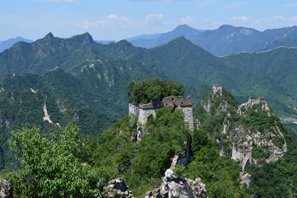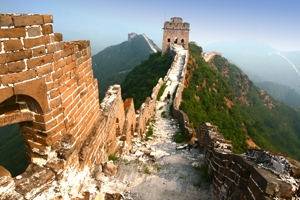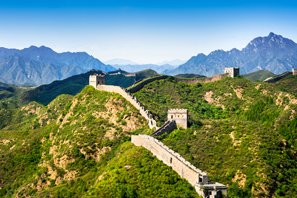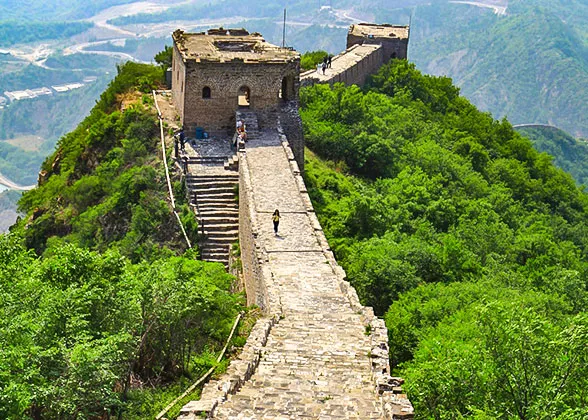10 Colossal Facts About the Great Wall of China
By tushar083 - August 19, 2017
| Top 10 Interesting Facts about the Great Wall of China |
 |
1. Contrary to common belief, the Great Wall of China cannot be seen from space with the naked eye. It can be seen with aid.
2. As early as the Qin Dynasty (221-207BC) when building the Great Wall, glutinous rice flour was used in making the binding material to bind the bricks. 3 .The sections of the Great Wall that we mostly associate with The Great Wall of China were built by the Ming Dynasty. This was the last part of the wall that was built and has been made with brick and features many tall watch-towers. 4. The Great Wall of China has been called the longest cemetery on Earth. Over a million people died building the Wall and archaeologists have found human remains buried under parts of the wall. 5. Although the official number of the length of the Great Wall is 8851.8 kilometers (5500 miles), the length of all the Great Wall built over thousands of years is estimated at 21,196.18 kilometers (13,170 miles). The circumference of the Equator is 40,075 kilometers (24,901 miles). 6 . The Great Wall of China is threatened with erosion. The northwestern sections (e.g. in Gansu and Ningxia provinces) of the Great Wall are deteriorating so quickly. It is believed that these sections may disappear within 20 years, due to demolishment by nature and human. 7. Over 10 million people visit the Great Wall of China every year. The most famous section of the Great Wall-Badaling, had been visited by over 300 heads of state and VIPs from around the world, the first of which was Soviet. But it is also the busiest section of wall which is restored. If you are a hiker who like to see the real unspoiled Great Wall which is off the beaten path, we don’t suggest you go there. 8. During the Cultural Revolution (1966-1976), many bricks of the Great Wall were taken away to use in building homes, farms or reservoirs. Otherwise many sections of the Great Wall would be preserved much better than what they are like today. 9. The Great Wall is wide enough in some places to drive a car over it. 10 . The most well known of all of the legends of The Great Wall of China is the story of "Men Jiangnu’s Bitter Weeping" whose husband died building the wall. Her weeping was so bitter that a section of the wall collapsed, revealing her husband’s bones so she could bury them. 11. Huge Man-Made Damage since the 1960s
During the Cultural Revolution from 1960s to 1970s, miles of the Wall were vandalized or destroyed to make way for infrastructure construction. Many bricks were moved to build civilian houses or farms. From 1980s to 1990s, some people even pillaged the bricks and sold them. It was common to see the ramparts being reduced to give way to road or factory construction. There was no clear regulation on the conservation of the Wall until 2006.
12. The Wall is Sadly Called the Longest Cemetery in the World
In 2,500 years of construction history of the massive project, more than 1,000, 000 laborers had been used, including civilians, soldiers, and convicts. It was a special punishment for convicted criminals during the Qin (221 - 207BC) and Han (202BC - 220AD) Dynasties. The toilsome work took many lives. It is estimated that around 400,000 builders were died and some are said to be buried in the long wall. That gives the dreadful saying of the ‘longest cemetery’. Don’t worry! So far, there has been no actual evidence of the walls containing corpses.
13. Most Widely-Spread Legend – The Cry of Meng Jiangnu
A tragic trivia is known to every household in China. Once there was a woman named Meng Jiangnu, whose husband Fan Xiliang was forcibly recruited to help build the Great Wall just three days after their marriage. Meng missed her husband so much that she decided to visit him. When she arrived at the building site, she was informed that Fan had died of exhaustion and been buried inside the wall. She was heart-broken and cried day and night. Finally, the wall collapsed and exposed her husband’s bones.
14. Westerners’ First Acquaintance with the Wall in 16th Century
In 1987, the Great Wall was designated as a UNESCO World Heritage site. Today, it is recognized as the emblem of China and attracts numerous international visitors. However, before the 20th century, it was seldom described in any Chinese artwork. To the contrary, early in the 16th century, this great architecture was gradually known by Westerners. The earliest record was from a Portuguese writer, saying that there was a long and solid wall in China with heavy garrison. In 1575, a Spanish envoy also commended the grand wall when he got back to Europe. In 1793, a British painter’s picture marked the first appearance of the Great Wall in Western paintings. Since 19th century, the Wall gradually won popularity among tourists.
15. Special Binding Agent from Grain
The building materials of the walls included the rammed earth, bricks, stones and rocks. What was the mortar? Here comes a fun fact - it was totally different from the modern mixture of sand and cement, as it included glutinous rice flour. Processed rice flour served as a reliable adhesive.
   | ||||


0 comments